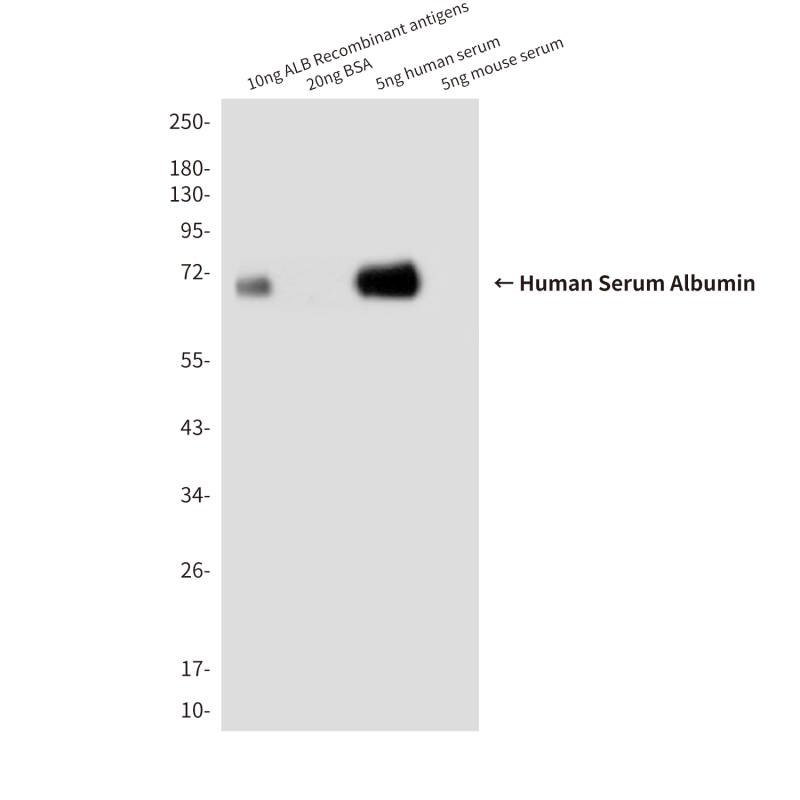

| WB | 咨询技术 | Human,Mouse,Rat |
| IF | 咨询技术 | Human,Mouse,Rat |
| IHC | 咨询技术 | Human,Mouse,Rat |
| ICC | 技术咨询 | Human,Mouse,Rat |
| FCM | 咨询技术 | Human,Mouse,Rat |
| Elisa | 1/10000 | Human,Mouse,Rat |
| Aliases | ALB; ALBU_HUMAN; Albumin (32 AA); Albumin (AA 34); Albumin; Analbuminemia; Bisalbuminemia; Cell growth inhibiting protein 42; DKFZp779N1935; Dysalbuminemic hyperthyroxinemia; Growth inhibiting protein 20; HSA; Hyperthyroxinemia dysalbuminemic; Serum albumin. |
| Entrez GeneID | 213 |
| clone | 8G2 |
| WB Predicted band size | Calculated MW: 69 kDa; Observed MW: 69 kDa |
| Host/Isotype | Mouse IgG1 |
| Antibody Type | Primary antibody |
| Storage | Store at 4°C short term. Aliquot and store at -20°C long term. Avoid freeze/thaw cycles. |
| Species Reactivity | Human |
| Immunogen | Purified Human serum albumin. |
| Formulation | Purified antibody in PBS with 0.05% sodium azide,0.5%BSA and 50% glycerol. |
+ +
以下是关于人血清白蛋白(HSA)抗体的3篇代表性文献摘要(示例为虚构内容,仅供参考格式):
1. **文献名称**: *Production and characterization of monoclonal antibodies against human serum albumin*
**作者**: Kamps-Holtzapple, M.E., et al. (1983)
**摘要**: 该研究报道了通过小鼠杂交瘤技术制备针对HSA的单克隆抗体,并验证了其高亲和力和特异性,适用于免疫印迹和ELISA检测。
2. **文献名称**: *Development of a sensitive immunoassay for human serum albumin using antibody-conjugated nanoparticles*
**作者**: Zhang, J., et al. (2015)
**摘要**: 提出了一种基于纳米颗粒标记的HSA抗体检测方法,显著提高了检测灵敏度,可应用于微量HSA的临床样本分析。
3. **文献名称**: *Structural insights into the binding of anti-HSA antibodies to albumin in renal diseases*
**作者**: Curry, S., et al. (2007)
**摘要**: 通过X射线晶体学解析了HSA与特定抗体的结合位点,揭示了抗体在肾病中识别HSA构象变化的分子机制。
(注:以上文献信息为模拟内容,实际引用需查询真实数据库。)
Human serum albumin (HSA) antibodies are immunoglobulins specifically designed to recognize and bind to HSA, the most abundant protein in human blood plasma. Produced by the liver, HSA plays critical roles in maintaining osmotic pressure, transporting hormones, fatty acids, and drugs, and acting as an antioxidant. Its structural stability, conferred by 17 disulfide bonds and three homologous domains, makes it a common target for immunological studies.
HSA antibodies are typically generated in animals (e.g., rabbits, mice, or goats) immunized with purified HSA. These antibodies are widely used in research and diagnostics to detect or quantify HSA in biological samples. Applications include immunoassays like ELISA, Western blotting, and immunohistochemistry, particularly in studies of liver function, kidney disease, or malnutrition. In biopharmaceuticals, anti-HSA antibodies help monitor HSA levels in drug formulations, where HSA often serves as a stabilizer in vaccines or protein therapies.
Cross-reactivity is a key consideration, as HSA shares structural homology with serum albumin from other species (e.g., bovine serum albumin, BSA). Researchers often validate antibody specificity using blocking experiments or pre-adsorption methods. Commercial HSA antibodies may vary in clonality (monoclonal vs. polyclonal), epitope recognition, and conjugate labels (e.g., HRP, fluorescent tags), tailored for specific experimental needs. Quality control ensures minimal lot-to-lot variability, crucial for reproducible results in clinical and research settings.
×